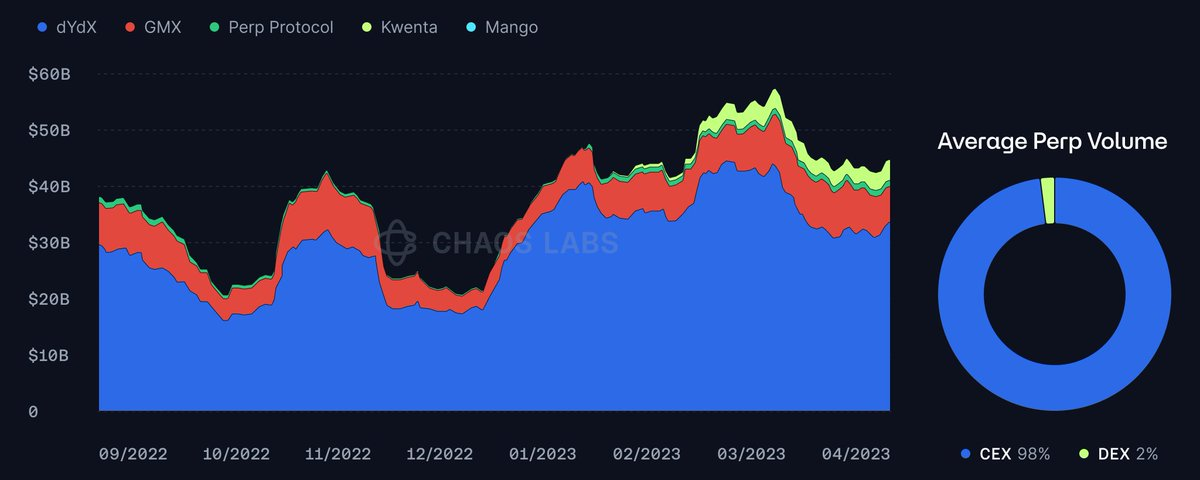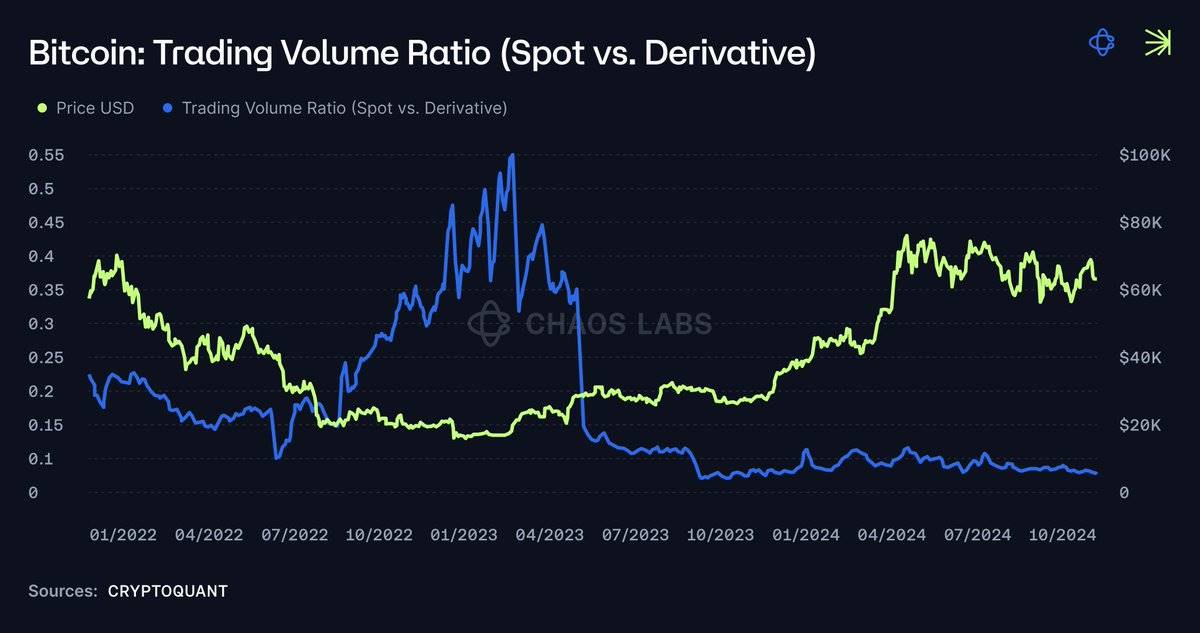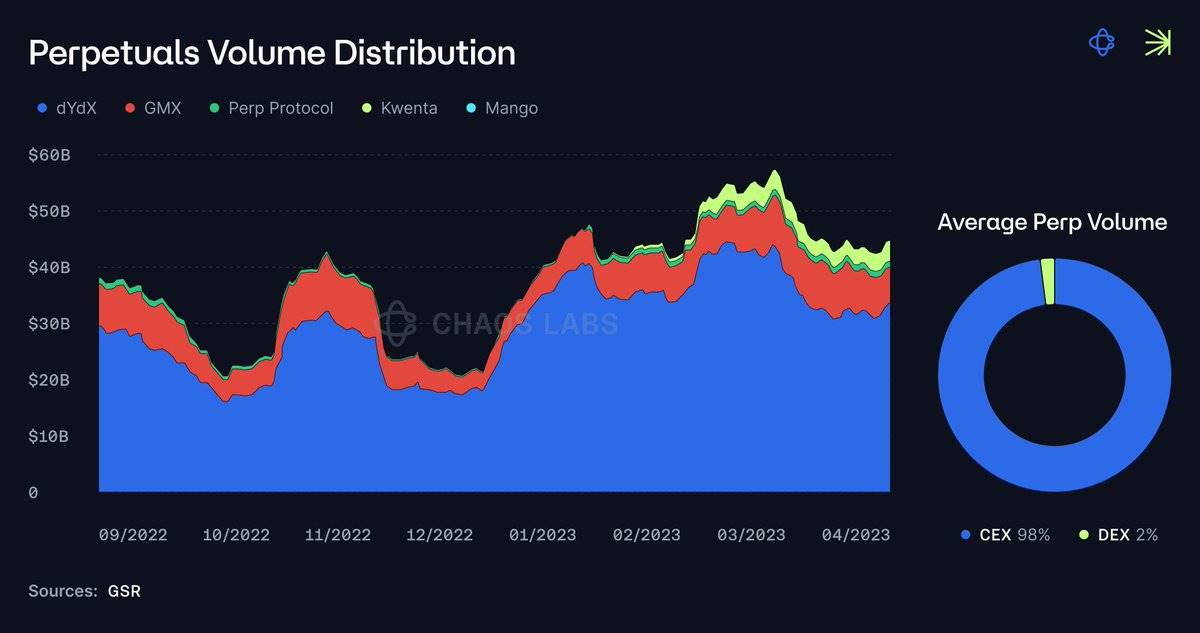This article will discuss the hard liquidity support model and the synthetic model.
Author: Chaos Labs
Compiled by: Deep Tide TechFlow

Written by research analyst @0xGeeGee
In both traditional finance and the cryptocurrency space, the scale of the derivatives market far exceeds that of the spot market. For example, as of now, the daily spot trading volume of Bitcoin is approximately $4 billion, while its derivatives trading volume reaches as high as $53.89 billion (data source: Cryptoquant.com).

Bitcoin: Trading Volume Ratio (Spot vs Derivatives) — Source: CryptoQuant
This trend has been accelerating since early 2021 and continues to this day. The derivatives market in traditional finance has long surpassed the spot market, and the derivatives market in centralized exchanges (CEX) for cryptocurrencies is following suit. In the decentralized finance (DeFi) space, derivatives have yet to exceed the spot market of decentralized exchanges (DEX). For instance, in the past 24 hours, @Uniswap v3 facilitated $1.3 billion in spot trades, while @HyperliquidX processed about $1 billion in derivatives trades (data source: Coingecko Data).
Nevertheless, the gap is narrowing, and it is clear that as the ecosystem matures, on-chain derivatives may eventually surpass the spot market, just like other mature markets. While market demand is shifting towards derivatives, this growth requires secure and efficient trading platforms and models to support it.

Derivatives Trading Volume — Source: DefiLlama
Understanding the different models that support the derivatives market is crucial for building the infrastructure that facilitates this transition. In this article, I will discuss the hard liquidity support model and the synthetic model.
Hard Liquidity Support Model
In the hard liquidity support model, traders transact with real assets, tokens, or stablecoins stored in a liquidity pool. These assets are essentially lent to traders for opening margin positions. Examples of platforms using this approach include @GMXIO, @JupiterExchange, @GearboxProtocol with PURE, and @Contangoxyz.
Liquidity providers (LPs) earn trading fees by depositing hard assets and may receive rewards as counterparties to traders. Therefore, LPs' earnings depend on the performance of the assets in the pool, the utilization rate of the pool, and in models without mechanisms to balance long and short trading volumes, the profits and losses of traders.
Advantages:
Lower bankruptcy risk: Since trading is backed by real assets, the risk of system bankruptcy is lower.
DeFi composability: Hard support models like GMX and Jupiter allow for the re-collateralization of liquidity pool tokens: $GLP and $JLP tokens can be used as collateral or staked in other DeFi applications, enhancing capital efficiency.
Lower trading/market-making incentive requirements: Since LPs act as counterparties or market makers, the importance of direct incentives is reduced. While in the early stages, LPs typically receive rewards through token incentives, in the long run, the returns from providing liquidity mainly come from trading fees, reducing the complexity of designing balanced trading incentive programs.
Deepening market liquidity: The hard support model promotes deeper market liquidity by requiring a liquidity basket backed by actual assets. Over the past few years, this has also made protocols like GMX one of the most efficient places to exchange spot assets, as liquidity is concentrated in pools that can serve both derivatives and spot markets.

The number of protocols and pools, including GLP and JLP yields, can be seen from the screenshot from DefiLlama.
Within this category, different sub-models have emerged based on how liquidity is acquired and shared:
GMX v1 and Jupiter: These protocols use a globally shared liquidity pool, where all assets are pooled together. This model ensures deep liquidity and enhances composability by allowing liquidity providers to use a single token across different DeFi protocols.
GMX v2 and Gearbox's PURE: Introduced a modular architecture with isolated liquidity pools, where each asset or market has its dedicated liquidity pool. This reduces systemic risk for the protocol, allowing it to support longer-tail, higher-risk assets. The risk and return of each asset are independent, preventing a single asset from affecting the liquidity of the entire protocol and creating different risk/return characteristics.
In this "hard liquidity support" model, we can also see how Contango operates. While it is not a standalone model, Contango runs on top of existing lending protocols (like Aave) to provide a margin decentralized exchange experience. It utilizes real assets borrowed from lending pools and flash loan capabilities to create leveraged positions.
Synthetic Model
The hard liquidity support model ensures security and composability by requiring real assets as collateral, while the synthetic model takes a different approach.
In the synthetic model, trading typically does not rely on real assets for support; instead, these systems depend on order book matching, liquidity vaults, and price oracles to create and manage positions.
The design of synthetic models varies widely—some rely on peer-to-peer order book matching, with liquidity provided by active market makers, who can be professional or managed through algorithmic vaults, with liquidity being globally shared or market-isolated; others adopt a purely synthetic approach, where the protocol itself acts as the counterparty.
What is a liquidity vault?
In synthetic derivatives models, a liquidity vault is a centralized liquidity mechanism that provides the funding source needed for trading, whether directly supporting synthetic positions or acting as a market maker. Although the structure of liquidity vaults may vary slightly across different protocols, their primary purpose is to provide liquidity for trading.
These liquidity vaults are typically managed by professional market makers (like Bluefin stablecoin pools) or algorithms (like Hyperliquid, dYdX unlimited, Elixir pools). In some models, they are purely passive counterparty pools (like Gains Trade). Generally, these pools are open to the public, allowing the public to provide liquidity and earn rewards by participating in platform activities.
Liquidity vaults can be shared across listed markets, such as in Hyperliquid, or partially isolated, as seen in @dYdX unlimited, @SynFuturesDeFi, and @bluefinapp, with these methods having similar risks and returns to those previously mentioned.
Some protocols, like Bluefin, adopt a hybrid model, combining a globally managed liquidity vault by market makers and isolated algorithmic pools.
In the synthetic model, liquidity is typically provided by active users (peer-to-peer matching), liquidity vaults (as a backup), and market makers who quote buy and sell prices on the order book. As mentioned earlier, in some purely synthetic models, such as @GainsNetwork_io, the liquidity vault itself acts as the counterparty for all trades, thus eliminating the need for direct order matching.
Advantages:
The trade-offs of synthetic models differ from those of hard liquidity support models, but they also bring a range of advantages:
Capital efficiency: Synthetic models are highly capital efficient because they do not require direct 1:1 backing of physical assets. As long as there is sufficient liquidity to cover the potential outcomes of active trades, the system can operate with fewer assets.
Asset flexibility: These systems are more flexible in terms of trading assets since positions are synthetic. There is no need to provide direct liquidity for each asset, allowing for a more diverse range of trading pairs and enabling faster—sometimes even semi-permissioned—listing of new assets.
This is particularly evident in the pre-release markets of Hyperliquid, where the assets traded in these markets may not even exist yet.
Better price execution: Since trades are purely synthetic, it is possible to achieve better price execution, especially when market makers are active on the order book.
However, these models also have some significant drawbacks:
Dependence on oracles: Synthetic models are highly dependent on price oracles, making them more susceptible to related issues such as oracle manipulation or delays.
Lack of liquidity contribution: Unlike hard support models, synthetic trading does not contribute to the global spot liquidity of assets, as liquidity only exists within the order book of derivatives.
Despite decentralized exchanges accounting for a relatively small proportion of the overall perpetual contract trading volume (about 2% of the market) compared to centralized exchanges, diverse models are laying the groundwork for future actual growth. The combination of these models, along with continuous improvements in capital efficiency and risk management, will be key for decentralized exchanges to expand their market share in derivatives.

Perpetual Contract Trading Volume Distribution — Source: GSR Annual Report
Contribution of Chaos Labs
Chaos Labs plays a significant role in risk management for hard support liquidity and synthetic models, catering to the specific needs of our partner platforms such as @GMX_IO, @dYdX, @SynFuturesDeFi, @JupiterExchange, @OstiumLabs, and @Bluefinapp.
As a long-term provider of risk analysis, Chaos Labs helps protocols manage leverage limits, liquidation thresholds, collateral requirements, and overall platform health through real-time risk assessments and simulations.
Chaos Labs' latest product, Edge Network, introduces a decentralized oracle system that helps reduce risks associated with oracles, ensuring that both synthetic and hard support models can benefit from real-time, accurate price data. Edge has already been used as a primary oracle by well-known platforms like Jupiter.
Chaos Labs also collaborates with partners to develop optimized liquidity incentive programs to ensure a smooth trading experience and attract more liquidity.
Finally, Chaos Labs provides public dashboards for monitoring risk parameters on platforms such as GMX, Jupiter, Bluefin, and dYdX.
免责声明:本文章仅代表作者个人观点,不代表本平台的立场和观点。本文章仅供信息分享,不构成对任何人的任何投资建议。用户与作者之间的任何争议,与本平台无关。如网页中刊载的文章或图片涉及侵权,请提供相关的权利证明和身份证明发送邮件到support@aicoin.com,本平台相关工作人员将会进行核查。




